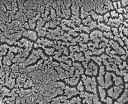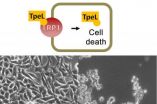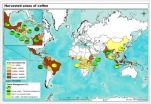Vanderbilt researchers discover how intestinal cells build nutrient-absorbing surface
2014-04-16
(Press-News.org) The "brush border" – a densely packed array of finger-like projections called microvilli – covers the surfaces of the cells that line our intestines.
Vanderbilt University researchers have now discovered how intestinal cells build this specialized structure, which is critical for absorbing nutrients and defending against pathogens. The findings, published April 10 in the journal Cell, reveal a role for adhesion molecules in brush border assembly and increase our understanding of intestinal pathologies associated with inherited and infectious diseases.
Pathogens that destroy the intestinal brush border cause diarrhea and death – a particular problem in communities that do not have safe water supplies.
"Without a fully functional brush border that has enough surface area and absorptive capacity, you can't survive," said Matthew Tyska, Ph.D., associate professor of Cell and Developmental Biology and senior author of the Cell paper. "Our basic science discoveries provide a framework for thinking about how to control intestinal surface morphology – and how to repair it."
Despite the essential role of the brush border, its assembly has remained a mystery. Using scanning electron microscopy, Tyska and postdoctoral fellow Scott Crawley, Ph.D., followed the generation of the brush border over time in an epithelial cell culture model.
They found that as the microvilli begin to emerge, they stick to each other at their tips and form small teepee-like clusters. Over time, these clusters grow to include more and more microvilli, until the entire cell surface is covered by microvilli of uniform height.
"This was really the fundamental observation that gave rise to the rest of the project – that these microvilli come out of the cell surface and stick together at the tips," Tyska said.
When the investigators closely examined the electron micrographs, they saw thread-like links connecting microvilli at their tips. One of their collaborators imaged intestinal tissue and found the same links – a "web of connections" between the microvilli, Tyska said.
"We were excited by the idea that physical adhesion between microvilli might provide the driving force for growing and tightly packing the brush border," Tyska said.
The investigators suspected that proteins in the cadherin family – calcium-dependent adhesion molecules that allow cells to stick together – might mediate the interaction between microvilli. They had previously used proteomics technologies to define all of the proteins in the isolated brush border. The list included two candidates for microvillar tip adhesion: protocadherin-24 and mucin-like protocadherin.
In a series of studies, the team demonstrated that these two cadherins have a role in sticking microvilli together. Experimental reduction of protocadherin-24 in the cell culture model destroyed the brush border. Microvilli still formed, but they were not tightly packed and they had variable lengths.
"It's always been a question how microvilli achieve this remarkably uniform length," Tyska said. "Now it looks like the solution is simple – they get tied together at the tips and one can't get past another. It's really straightforward."
In biochemical experiments, the researchers discovered that the cadherin molecules interacted with two proteins inside microvilli – a motor protein connected to the cell cytoskeleton and an adapter protein called harmonin. These connections were required for the localization of the cadherins to the microvillar tips.
Interestingly, harmonin had been studied by other investigators for its role in linking protrusions on the inner ear hair cell – a sensory structure involved in hearing. Genetic mutations that disable harmonin cause Usher syndrome, a form of inherited deaf-blindness. Patients with Usher syndrome also have poorly characterized intestinal disease.
Tyska and his colleagues realized that harmonin mutations might disrupt the intestinal microvillar tip adhesion complex and destabilize the brush border. In a mouse missing harmonin, a model of Usher disease, they found poorly formed brush border in some parts of the intestines and no brush border in other areas.
"We think that patients with Usher disease probably have issues with brush border ultrastructure that are causing problems with homeostasis and leading to intestinal symptoms," Tyska said.
"Making the initial electron microscopy discovery, defining the molecular mechanism and then connecting it to human disease – that's a scientific hat trick," he said.
Tyska and his colleagues are exploring whether a similar adhesive complex guides the assembly of brush border structures in other epithelial tissues, such as the kidneys.
INFORMATION:
Cell featured Tyska's paper in a video abstract.
Other contributors to the current studies include members of Tyska's group: previous graduate students Russell McConnell, Ph.D., Andrew Benesh, Ph.D., and David Shifrin, Ph.D., current graduate student Nathan Grega-Larson and research assistant Suli Mao, and also collaborators at the National Institutes of Health: Bechara Kachar, M.D., and Bryan Millis, Ph.D.
The research was supported by grants from the NIH (DK075555, DK095811, DK058404, DC009246) and the American Heart Association, and by a Vanderbilt Innovation and Discovery in Engineering And Science (IDEAS) award.
ELSE PRESS RELEASES FROM THIS DATE:
Surveillance colonoscopy recommendations for average-risk patients with 1 to 2 small polyps consistent with guidelines
2014-04-16
DOWNERS GROVE, Ill. – April 16, 2014 – According to a new study, endoscopists' recommendations for timing of surveillance colonoscopy in average-risk patients with one to two small polyps are consistent with guideline recommendations in about 90 percent of cases. This may be an appropriate target for quality indicators. This is the first multicenter endoscopic database study to quantify adherence to guidelines for timing of repeat colonoscopy after one to two small polyps are found during screening colonoscopy in average-risk patients. The study appears in the April issue ...
Scientists capture ultrafast snapshots of light-driven superconductivity
2014-04-16
A new study pins down a major factor behind the appearance of superconductivity—the ability to conduct electricity with 100 percent efficiency—in a promising copper-oxide material.
Scientists used carefully timed pairs of laser pulses at SLAC National Accelerator Laboratory's Linac Coherent Light Source (LCLS) to trigger superconductivity in the material and immediately take x-ray snapshots of its atomic and electronic structure as superconductivity emerged.
They discovered that so-called "charge stripes" of increased electrical charge melted away as superconductivity ...
Eavesdropping on brain cell chatter
2014-04-16
Everything we do — all of our movements, thoughts and feelings – are the result of neurons talking with one another, and recent studies have suggested that some of the conversations might not be all that private. Brain cells known as astrocytes may be listening in on, or even participating in, some of those discussions. But a new mouse study suggests that astrocytes might only be tuning in part of the time — specifically, when the neurons get really excited about something. This research, published in Neuron, was supported by the National Institute of Neurological Disorders ...
How kids' brain structures grow as memory develops
2014-04-16
Our ability to store memories improves during childhood, associated with structural changes in the hippocampus and its connections with prefrontal and parietal cortices. New research from UC Davis is exploring how these brain regions develop at this crucial time. Eventually, that could give insights into disorders that typically emerge in the transition into and during adolescence and affect memory, such as schizophrenia and depression.
Located deep in the middle of the brain, the hippocampus plays a key role in forming memories. It looks something like two curving fingers ...
Theoretical biophysics: Adventurous bacteria
2014-04-16
To reproduce or to conquer the world? Surprisingly, bacteria also face this problem. Theoretical biophysicists at Ludwig-Maximilians-Universitaet (LMU) in Munich have now shown how these organisms should decide how best to preserve their species.
The bacterium Bacillus subtilis is quite adaptable. It moves about in liquids and on agar surfaces by means of flagella. Alternatively, it can stick to an underlying substrate. Actually, the bacteria proliferate most effectively in this stationary state, while motile bacteria reproduce at a notably lower rate.
In order to sustain ...
Significant baseline levels of arsenic found in Ohio soils are due to natural processes
2014-04-16
RICHLAND, Wash. – Geologic and soil processes are to blame for significant baseline levels of arsenic in soil throughout Ohio, according to a study published recently in the Journal of Environmental Quality.
The analysis of 842 soil samples from all corners of Ohio showed that every single sample had concentrations higher than the screening level of concern recommended by the U.S. Environmental Protection Agency. The findings should not alarm the public, say the authors, who note that regulatory levels typically are set far below those thought to be harmful. Rather, the ...
Preterm births, multiples, and fertility treatment
2014-04-16
While it is well known that fertility treatments are the leading cause of increases in multiple gestations and that multiples are at elevated risk of premature birth, these results are not inevitable, concludes an article in Fertility and Sterility. The article identifies six changes in policy and practice that can reduce the odds of multiple births and prematurity, including expanding insurance coverage for in vitro fertilization (IVF) and improving doctor-patient communications about the risks associated with twins.
Financial pressures provide a powerful incentive for ...
Gate for bacterial toxins found
2014-04-16
Prof. Dr. Dr. Klaus Aktories and Dr. Panagiotis Papatheodorou from the Institute of Experimental and Clinical Pharmacology and Toxicology of the University of Freiburg have discovered the receptor responsible for smuggling the toxin of the bacterium Clostridium perfringens into the cell. The TpeL toxin, which is formed by C. perfringens, a pathogen that causes gas gangrene and food poisoning. It is very similar to the toxins of many other hospital germs of the genus Clostridium. The toxins bind to surface molecules and creep into the body cell, where they lead to cell death. ...
Scientists explain how memories stick together
2014-04-16
LA JOLLA—Scientists at the Salk Institute have created a new model of memory that explains how neurons retain select memories a few hours after an event.
This new framework provides a more complete picture of how memory works, which can inform research into disorders liked Parkinson's, Alzheimer's, post-traumatic stress and learning disabilities.
"Previous models of memory were based on fast activity patterns," says Terry Sejnowski, holder of Salk's Francis Crick Chair and a Howard Hughes Medical Institute Investigator. "Our new model of memory makes it possible to ...
Shade grown coffee shrinking as a proportion of global coffee production
2014-04-16
The proportion of land used to cultivate shade grown coffee, relative to the total land area of coffee cultivation, has fallen by nearly 20 percent globally since 1996, according to a new study by scientists from The University of Texas at Austin and five other institutions.
The study's authors say the global shift toward a more intensive style of coffee farming is probably having a negative effect on the environment, communities and individual farmers.
"The paradox is that there is greater public interest than ever in environmentally friendly coffee, but where coffee ...








